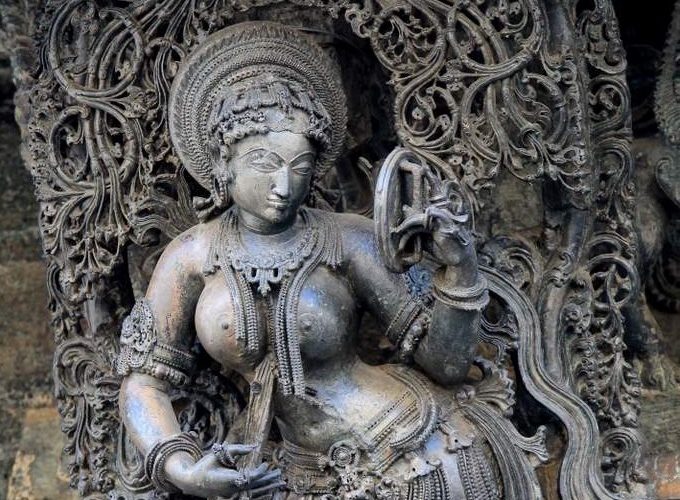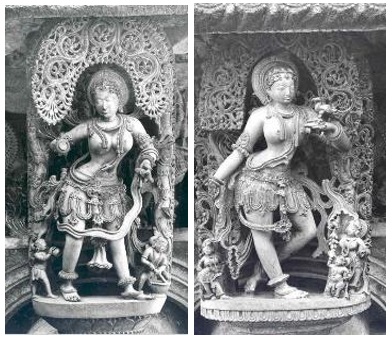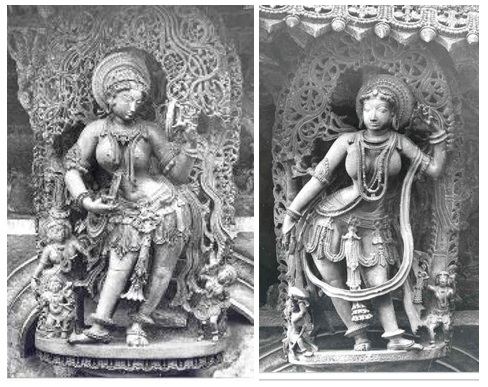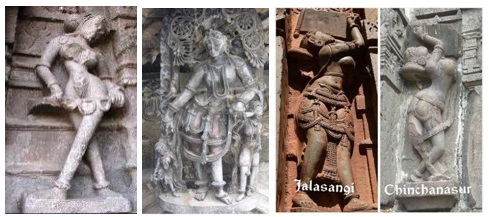Abstract
Shringara rasa – the sentiment of erotic love, and first of the nine rasas / navarasas as they are called are the natural states of mind experienced by humans. Of the nine sentiments -nava rasas, shringara occupies an important place in the history of ancient Indian literature and fine arts. Indian temples show the figures of apsaras depicting the sentiment of love, both in the theoretical aspects relating to theatrics (as described in Natyashastra by Bharata Muni around 2nd century AD) as well as in the practical side of life with Kamasutra of Vatsyayana (by sage Vatsyayana, around 2-3 century AD) as its base. Many erotic sculptures depicting union also involve dwarf figures at the base as secondary figures which are in pranayama variations with hatha yoga mudras and are tantra based union figures. (Though based on Patanjali Yoga sutra assigned between 3-4th century AD, Hatha yoga gained prominence beyond 5th century AD). Several commentaries on these topics were written in the subsequent periods and by medieval period the kings who sponsored the construction of temples, the sthapatis and sculptors were all well versed on these topics along with religious and philosophical aspects. The outcome was the inclusion of these topics in a permanent medium of stone in temples for mass communication. This article focuses on how to understand the shades of shringara rasa that are depicted on the outer walls of Indian temples and how tantric themes are different from non-tantric ones as they are based on different ancient texts.
Introduction to Shringara Rasa
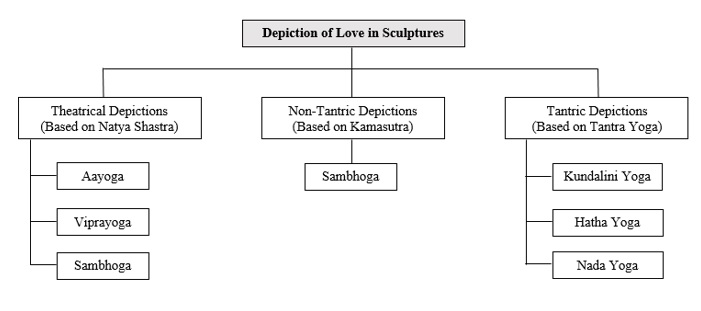 The depiction of a happy state of mind elevating the state of mind of the performer and the viewer to shringa- meaning a peak is called Shringara rasa and is called the “King of Rasas”. It is categorized as chitta vikasa (blooming of the mood) – which blossoms or opens out the mind leading to a pleasant state. Rasa means the essence, pith – the juicy and the best part of Indian fine arts like dance, music, painting, sculptural art and literature. In colloquial terms, it means beautification, pure and clean leading to attractive appearance and is related to the love theme of youthful enthusiastic hero and heroine. Feminine grace in youth, is the support of Shringara in sculptures too, and they show joyful facial expression with befitting actions through limbs.
The depiction of a happy state of mind elevating the state of mind of the performer and the viewer to shringa- meaning a peak is called Shringara rasa and is called the “King of Rasas”. It is categorized as chitta vikasa (blooming of the mood) – which blossoms or opens out the mind leading to a pleasant state. Rasa means the essence, pith – the juicy and the best part of Indian fine arts like dance, music, painting, sculptural art and literature. In colloquial terms, it means beautification, pure and clean leading to attractive appearance and is related to the love theme of youthful enthusiastic hero and heroine. Feminine grace in youth, is the support of Shringara in sculptures too, and they show joyful facial expression with befitting actions through limbs.
Most of the Apsara sculptures are based on different aspects of Shringara rasa, adhering to the rules prescribed in the treatise of Indian theatrics- Natyashastra. The chapter on sentiments is about the rules of theatrical aspects giving a detailed account of how the Shringara rasa has to be enacted by the heroine of the play, how the state of mind has to be communicated to the audience with befitting body and facial movements, accessories that can be used or the stage setting to invoke Shringara. The heroine depicted as an apsara on a lotus pedestal (considered as semi divine for her insight into fine arts) exhibits all the rules of Natyashastra to be followed for depiction of Shringara. Shringara is the rasa used to portray on stage mutual desire and romantic love as primary emotion between a man and woman. The permanent mood – Sthayibhava of Shringara is Rati, meaning physical attraction and pleasure.
Dasharupaka, (an ancient commentary on some chapters of Natyashastra, compiled by Dhananjaya, around 10th century) in Part IV, Ch. 58, in relation to the state of mind of the hero and the heroine, states that Shringara is of three stages –
“Aayogo viprayogascha sambhogascheti sa tridha”
- Aayoga stands for acceptance of each other in love, are in a pleasant state of mind, though yet to meet, are ambitious of the meet as a precursor to union. Most of the Apsara sculptures depict the anxiety of Aayoga Shringara- as she is interested in the hero and is preparing herself for the meet. But the hero is not physically depicted in this group of Apsara sculptures and hence are classified as Aayoga phase.
- Viprayoga – where the hero and heroine had united before, but are currently apart, in non-harmonious state, separated or quarrelling for the hero has missed the promise of coming in time to meet the heroine. The sculptural representations are rare but are more in paintings and literature.
- Sambhoga – where hero and heroine are in a harmonious state of mind and united. Sambhoga Shringara is the core theme of the treatise Kamasutra.
While the heartache and pain of separation from the loved one is conveyed through Viprayoga, the intense desire for uniting with the lover is conveyed through Sambhoga.
- Aayoga Shringara in Sculptures of Apsaras of Belur Chennakeshava Temple
‘Aa’, is the second letter of alphabet in Sanskrit and is used as a prefix to verbs and nouns to express a sense of nearness. Yoga means joining or union. Aayoga also means an appointment (for yoga-joining), action or performance, and offering flowers, perfumes, etc., as a sub division of Shringara. It is easier to express emotions in literature or dance, but to bring it out in a sculpture is difficult because the sculptor is the non-performer and yet has to know the intricacies involved in dance of both pure and emotive aspects, to bring out a state of pleasure in the stone medium. In other words, the sculptor had to know thoroughly all the aspects related to the chapters of Natyashastra as well as physical body because Shringara is expressed through body movements as frozen (aangika abhinaya) postures along with facial expressions and supported by other hand accessories.
The aesthetic pleasure of Apsara sculptures is determined by how successful the sculptor is in expressing a particular emotion and evoking the rasa.
“Ramya desha, kalaa, kaala, Veshabhogadi Sevanai…”
Dasarupaka, part 4.56 quotes that Shringara is evoked and depicted when the hero or heroine is enjoying in the following context.
- Ramya desha – A pleasant place like garden and enjoying nature
- Ramya kalaa – Involved in fine arts such as music, dance and the instruments.
- Ramya kaala – Pleasant time like pleasure of seasons or festivals. It could also be playing with pet parrot and hearing words about the hero from her pet parrot, etc.
- Vesha bhoga – Use of garlands, ornaments, food that elevates the mood to a pleasant state.
The context in sculptures is determined by the behaviour of the character of heroin – the Apsara.
Ramya Desha – Ramya means pleasant and desha means a place. A pleasant state of mind, Shringara rasa is evoked in a beautiful place like a garden or a palace when the heroine is enjoying the beauty of flower or a fruit. Garden is also a meeting place with her beloved. She holds the branch of a plant, and looks for the arrival of her beloved.
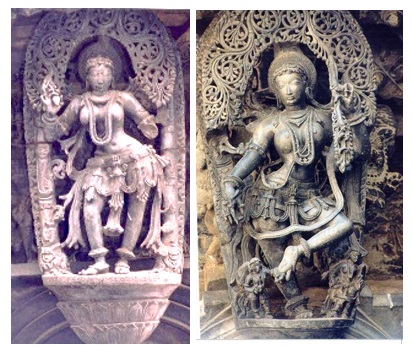
Picture 1 (left): From Belur. Depicts Apsara in a garden, trying to know the texture of a fruit.
Picture 2 (right): From the same temple shows Apsara trying to ask the attendant to examine her foot. She holds the branch for support and looks if the hero has arrived or not.
Ramya Kalaa – Kalaa means fine arts. Apsara is immersed in playing instrumental music and enjoying a pleasant state of mind. Shringara is evoked by actions depicting enjoyment in art forms. The face depicts a joyous state with a smiling face. Head and glances in sama (normal) position. Apsara is involved in music or dance, and the attendants with instruments belong to the Kushilava group of accompanying artists.
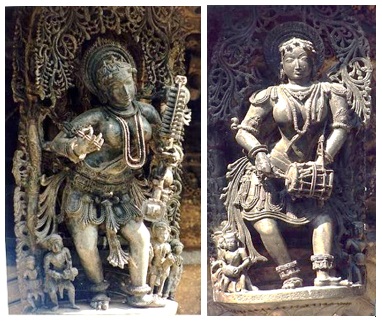
Picture 3 and 4: Apsara figures engrossed in playing string and percussion instruments, figures from Belur temple.
When the hero or heroine is involved in enjoying any art form like dance and music – the Gandharva Kalaa – they are depicting Shringara rasa – as it is categorized under blooming of the mind – citta vikaasa. Natyashastra defines Gandharva Kalaa as music and dance based on svara, taala and pada (melody, rhythm and words respectively) executed with various musical instruments. This was the art loved by Devas and Gandharvas who were proficient in music.
Ramya Kaala – Kaala is time, a pleasant or private time. The Apsara is speaking to her pet parrot and listening about the hero or enjoying Utsava kaala – a festive time. These are well depicted in figures of Belur.
Picture 5 depicts how the lady is enjoying the game of colours in Vasantotsava. She is in an enthusiastic game of playing with a pot full of perfumed or coloured water and also using a syringe to spray colours.
In Picture 6, the Apsara is associated with a pet parrot in a dramatic situation in sculpture. Parrot is the vehicle of Kamadeva- the God of love, hence, it is a symbolic gesture of love and a carrier of love messages. It may also be a friend and a soul mate with whom she shares her love for the hero. In this panel, the Apsara is either listening to its words about the hero or she is trying to receive or send a message through it. It is a frozen posture of a dialogue – vachikaabhinaya, and the dwarf figures depicted as encouraging the bird with fruits to speak repeatedly.
Vesha Bhogadi Sevanai: Apsara is deriving pleasure from personal decoration like a dress, ornaments or enjoying food etc., which elevates the mind to a pleasant state. Bhoga – the experience of enjoyment is possible through the help of manas – the mind in a pleasant state and not otherwise. Shringara through dress means and elegant decoration suited to an amorous interview.
These two pictures show her desire to look good before meeting her beloved. She carefully looks at herself in the mirror, arranging her adornment for final touches. The attendants are offering bangles for extra adornment. In Picture 8, she is trying to know which type of earrings suits her. The attendants are showing her the mirror and other ornaments.
Feminine grace in youthful period, supports the sentiments of Shringara. The natural physical graces are called Haava, Bhaava and Hela, (feminine coquettish gesture to excite love, emotion, and intensifying sexual desire, respectively) – which arise from one another and are aspects of natural character. The erotic emotion manifests itself in the change in position of eyes, eyebrows and the neck and graceful body movements, indicative of erotic sentiment. The various natural graces which a lady exhibits like amorous gesture, graceful hand movements, confusion, manifestation of affections and pretended anger are the outcome of the three inborn qualities of youthful period. Adorned with these natural graces a lady exhibits involuntary (without effort) graces – some of them which are seen in Apsara images. In her expression of love, the Apsara’s efforts are based on longing (abhilasha – as said in Sanskrit) to meet her beloved. She tries to decorate herself and exhibits anxiety before the meet. The analysis of sculptures in Shringara rasa is also supported by the actions of the dwarf figures who are depicted on either side of the main figure.
- Viprayoga Shringara in Sculptures
‘Vi’– is a prefix in Sanskrit to verbs and nouns or adjectives, with a meaning of separation, a reverse of action, an opposite of a verb of any action and prayoga means use or performance. Viprayoga, a subdivision of Shringara is separation after union. Due to emotional disturbances like forgetfulness of hero, when the hero is abroad due to work or jealousy felt by either of them, the hero and heroine are separated. The expression comes out as harsh vak-words or disinterest in dress and action. The lady in Viprayoga is depicted as removing her decorations, and in a bad mood of crying, breathless exhalations or writing a message about her state. Even when there is lot of love in their hearts, they are in angry mood and hence in Viprayoga state.
Picture 7 is a panel from Chalukyan temple that depicts a lady to be removing her adornment of the waist band. She appears to be disinterested in costume. The posture of crossing legs in the thigh region (Baddha swastika) is used to depict an unpleasant situation.
Picture 8 from Belur Chennakeshava temple of Hoysala art depicts a heroine in a disappointed mood after opening the message or the letter. The dwarf figure of a young girl helps in opening the message. The lady depicts her disappointment in downward head and glances without enthusiasm in her action.
Picture 9 and 10 are from Chalukyan temple. The lady is writing a letter to her beloved about her agony as he is away from her. The legs are crossed at a lower region which hints that she is in love but is separated from the hero.
- Sambhoga Shringara in Sculptures
Sambhoga Shringara – a sub division under Shringara, it refers to enjoyment in general, and to sexual love, erotic love, coitus, romantic mood highlighted by physical intimacy in particular. Bhoga is consuming, pleasure or enjoyment. Sambhoga is the central theme of Shringara, literally leading to union. It is reverse of Viprayoga separation or indifference of loved ones. Sambhoga is synonymous with ratikride, surata and maithuna that are expressed in sculptures through suitable actions like a hug, loving glance, inter twining of the body, etc. The sculptures depict male and female figures in a state of enjoyment in a relaxed state. Some depictions are according to the postures detailed in Kamasutra. Release of the creative sexual energy and procreation is the result of Sambhoga Shringara.
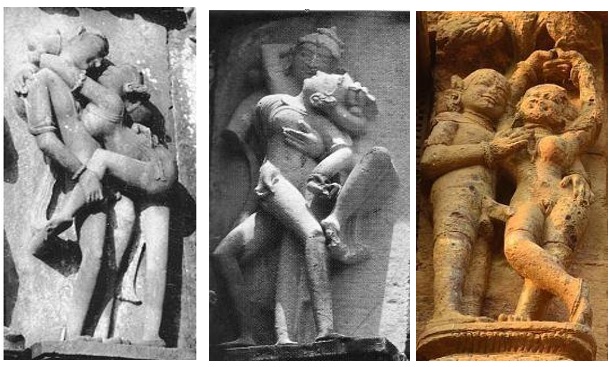
The pictures 11 (left) and 12 (middle) are from Khajuraho group of temples. Picture 13 (right) is from Konark temple.
The conclusion is that the variation in rasas offer a unique mode and testimony to the enduring beauties carved in these temples. It is truly beauty frozen in time. The depiction of Rasa in Apsara sculptures bear no relation to any Pauranic or mythological episodes, as there is no proof in support of this. Hence, it is viewed for a demonstration of how a particular Rasa is to be conveyed through angika, aharya and satvika modes. It is a demonstration of how a lady has to enact, for a particular situation. The emotions of love are natural human instincts and its various stages or shades are documented in the sculptures of temples.
Erotic sculptures: Depiction of Union in Tantra based Images
Many figures despite being adorned with garments and jewels appear nude with a bold display of genital organ and hence popularly addressed as erotic figures. The term erotic is related to sexual desire and is a part of Sambhoga Shringara. A study of such figures revealed that even though there is a bold display of body or intimacy between the male and the female, Shringara- the sentiment of love or physical attraction did not appear to be the key theme. The figures depicted hand gestures or yoga mudras, auspicious accessories along with the presence of secondary figures in hatha yoga postures. Such figures, when approached for the esoteric or the inner secretive information, lead to the understanding of hidden information. They were related to the profound matters of the fundamental reality of tantric practices, classified as Tantra yoga and its branches. The aspects of Raja yoga and Tantra philosophy were an integral part of the temple sculptures very much like the depiction of Pauranic or religious episodes that adorned the outer walls of the temple. These figures were carved out in temples so that people could know the different reality.
The Apsara Figure with a Scorpion on Her Thigh
Figures with this theme are depicted in almost all big temples. Though called erotic, she does not show the pleasantness of Shringara rasa, but pain or fear on her face and actions. A detailed study revealed that this bold exposure is due to the presence of scorpion and not intended to expose herself for sex. The symbolism of scorpion relates to the six negative or impure qualities like lust, anger, greed, envy, etc. and in particular to lust, which is depicted as a scorpion (Vruschika in Sanskrit). As per ancient literature, scorpion carries an ever-present aura of passion, lust, attraction. In sculptures, scorpion is always depicted as approaching the sex organ.
Being a large poisonous insect, its danger is depicted through the large fangs that are like swords. In almost all figures, the celestial beauty is depicted to be opening her costume out of fear to throw away the scorpion, thus resulting in the exposure of the genital organ. Sculptures with self-exposure, though called erotic, convey a message of over power of lust and its implications. Usually, scorpions are associated with only a female figure in order to convey the silent approach of lust. A woman must be careful as it turns out to be a physical and social problem when ignored.
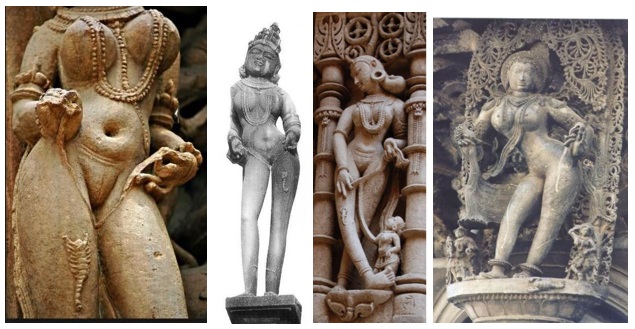
Pictures 14 (left most) and 15: From Khajuraho temples. Picture 16 is from Rani ki Vav and Picture 17 (right most) from Belur.
The figures of celestial beauties in the temples of medieval period like the Khajuraho temple, the step well of Rani ki vav and Belur temple of Hoysala art all have an Apsara figure associated with a scorpion.
The scorpion is usually depicted as climbing up towards the genital region. Every movement of it is adversary. It makes a stealthy, silent approach without making a bold display of its arrival and hides in thick layers. It strikes quickly and decisively and injects poison which paralyzes consciousness. This is depicted as the lady showing pain on her face. Since pain or fear are not in Shringara rasa, these sculptures though called erotic, are not depictions of erotic love. The intended message is that sexual energy can be harnessed to progress spiritually or excel in any other field.
Tantric Coupling
The sculptures depicting tantric coupling are focused more on highlighting the ecstatic state as the key expression rather than mundane pleasure. Ecstasy is essentially a stepping into an alternate reality in which the present reality disappears. The sculptures depicting union had secondary figures not only depicting hatha yoga asanas or mudras in hands but also showed instruments held in hand. This led to the understanding that Tantra used body as the best medium to explain its philosophy. The body was adopted as a symbol or an instrument through which truth and reality of Tantra could be realized. The aim of tantric coupling is not to discharge the creative sex energy, but to divert it to a path of spiritual evolution. They look like love sculptures from an optical view, but a rationalistic approach of the other figures in the panel leads to an understanding of the hidden philosophical concept. This could also be due to the fusion of the sambhoga postures of Kamasutra mixing with the thoughts of Tantra yoga to explain what the stages of union means, and how tantric union can be achieved. Probably the intention for a real-life depiction was to explain the term “union” because Tantra yoga refers to many unions such as:
- Ida – pingala nadis in union in Kundalini yoga
- Prana and apana aspects of pranayama in harmony in Hatha yoga or
- Mind and intellect in perfect harmony for spiritual progress in Nada yoga.
The two forces in each group were personified into male and female figures to explain or highlight union at different branches of Tantra yoga. Graphic images were used to carry a stronger and dramatic impact on the psyche of the humans. Realities of Tantra were conveyed both in its theoretical and practical aspects.
Though all the pictures from the Khajuraho group of temples provided below show the hero and heroine in loving embrace or union, the secondary figures that are carved along with the main figures convey the hidden information about different branches of Tantra yoga. The male and female figures are to be viewed as personifications of the union of either the ida-pingala nadis, prana-apana vayu, upaya and prajna of Buddhist Tantra, union of jivatma with paramatma or union of mind and mantra. Spiritual progress is the intention in Tantric union, and not procreation or physical pleasure of sambhoga.
Picture 18 shows Viparita Baddha Konasana and head stand depicted in sculptures of tantric coupling represent Yoga Nadis in Kundalini Yoga. The head stand, viparita baddha konasana by male figure is at the base and konasana by female figure is on the top. The two- male and female figures are the personification of the Ida – Pingala Nadis, (the motor and sensory nerves in physiological terms) uniting at the central Sushumna canal. The side figures are the peripheral Nadis, the nerves in personification.
Picture 19 shows four big figures and two small figures in sitting posture depicting hatha yoga mudras. The central male and female figures are the personification of prana and apana forces. The first female figure depicts absolution of slapping the nerves of the cheek in left hand before the commencement of hatha yoga and holds dhyana mudra in right hand, hinting about focus of mind. The last female figure depicts mula bandha in left hand and naadi shodha pranayama in right hand. The sitting figure between the legs show bhastrika pranayama with shakti chalana mudra of hatha yoga.
Picture 20 shows four big figures and three dwarf figures as Gandharvas holding flute and garland. The central figures gazing affectionately are about the depiction of the state of mind (mantra as female) under the control of prana (male) in total harmony. It is the state of uninterrupted bliss of nada yoga, a branch of Tantra yoga. At the culmination of this yogic practice, the yogi hears the anahata nada – unstruck and internal sound vibrations like that of flute and lute of immense bliss. The figures holding flute and the lute are as tall as the main figures indicate the soulful vibrations of the string and wind instrument, the flute and veena. This stage is depicted in the panel as the prana and mantra, personified as deities in embrace gazing at each other in harmony and other figures reverberating with the sound of flute are conveying the beauty of harmonious state union of mind with the intellect in Nada yoga.
The Veena of Goddess Saraswati, the flute of Lord Krishna and the Damaru nada of Lord Shiva are the symbolic sounds, which are the source of revelation to Naada-yogis. At this level of yoga, samadhi can only be an experience rather than a discussion.
References
The following books by the author provide detailed analyses of the topics covered in this article:
Apsaras in Hoysala Art: A New Dimension.
Erotic Sculptures in Indian temples: A New Perspective.
The books are available at: www.amazon.com/author/rekharao
Featured Image: Thrilling Travel
Disclaimer: The facts and opinions expressed within this article are the personal opinions of the author. IndiaFacts does not assume any responsibility or liability for the accuracy, completeness,suitability,or validity of any information in this article.
Independent Researcher and Indologist, Mysore

